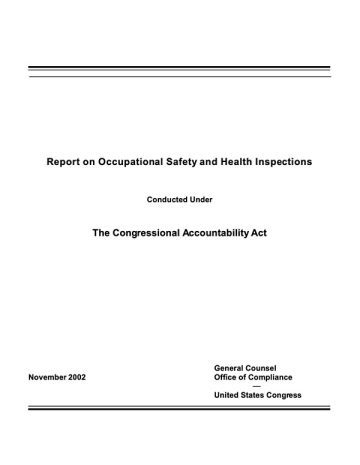Dear Mr. Speaker and Senator Byrd:
Section 215(e) of the Congressional Accountability Act of 1995, 2 U.S.C. 1314(e), requires the General Counsel of the Office of Compliance to conduct periodic inspections, at least once each Congress, of all Legislative Branch facilities for compliance with employee health and safety standards. On the basis of such inspection, the General Counsel is directed to prepare and submit a report identifying the violations uncovered, describing the steps necessary to achieve their abatement, and assessing the associated risks to employee health and safety. The inspection of facilities during the One Hundred Seventh Congress has been conducted, the results have been compiled, and the mandated Report is herewith delivered.
The events of September 11, 2001, have influenced the focus of this Report. As we show, many occupational safety and health standards deal directly with the planning, training, operations and equipment necessary to minimize the casualties of terrorism. Subjects like emergency evacuation, fire suppression, emergency communication methods, and chemical/biological response plans are regulated in detail. These regulations, promulgated at a time when most fire, explosions and toxic releases were considered accidental, will serve both employers and employees well in an age when such hazards are often inflicted deliberately.
Respectfully submitted,
Gary Green
General Counsel
I. EXECUTIVE SUMMARY
The focus of this Report is emergency preparedness. Several Occupational Safety and Health Act (“OSHA”) standards bear directly on this issue. This Report describes those standards and the state of compliance by the Legislative Branch. We have found significant improvement in this area since our first Report in 1996, and particularly since the terrorist attacks of September 11, 2001. There are still, however, some important deficiencies, specifically in matters such as emergency action plans, evacuation plans, chemical/biological response, communications, and fire safety systems, which we discuss in detail in this Report.
There has also been an overall improvement in workplace safety during the 107th Congress. Our inspectors found that most House and Senate offices had an effective emergency plan which was well communicated to employees. Of particular note were the actions of the Capitol Police in coordinating the individual office plans with overall evacuation plans for Capitol Hill. There remain deficiencies in the audibility of fire alarm systems, primarily in the Capitol, in communication systems for both employees and responders and in fire and life safety systems.
In our inspections of non-office facilities, we found significant safety issues relating to blockage of fire extinguishers and sprinklers, inadequate fire alarm systems, blockage of egress routes, inadequate exit signs and emergency lighting, failure to inspect fire extinguishers and electrical hazards.
Our Report also notes the markedly improved safety record of the Architect of the Capitol (“AOC”). In our 1998 Report to the Congress, we stated that the AOC had the highest accident rate among all federal government agencies. That rate has been reduced in the most recent two-year period. This improvement is due, we believe, to the Architect’s commitment to improving the safety of working conditions on Capitol Hill and to the recruitment of competent and motivated professional safety staff.
